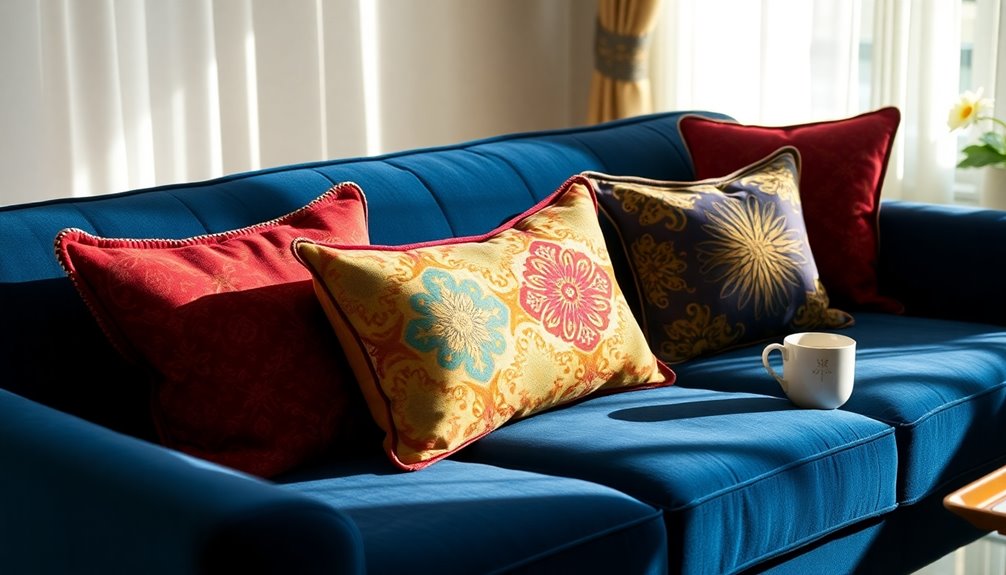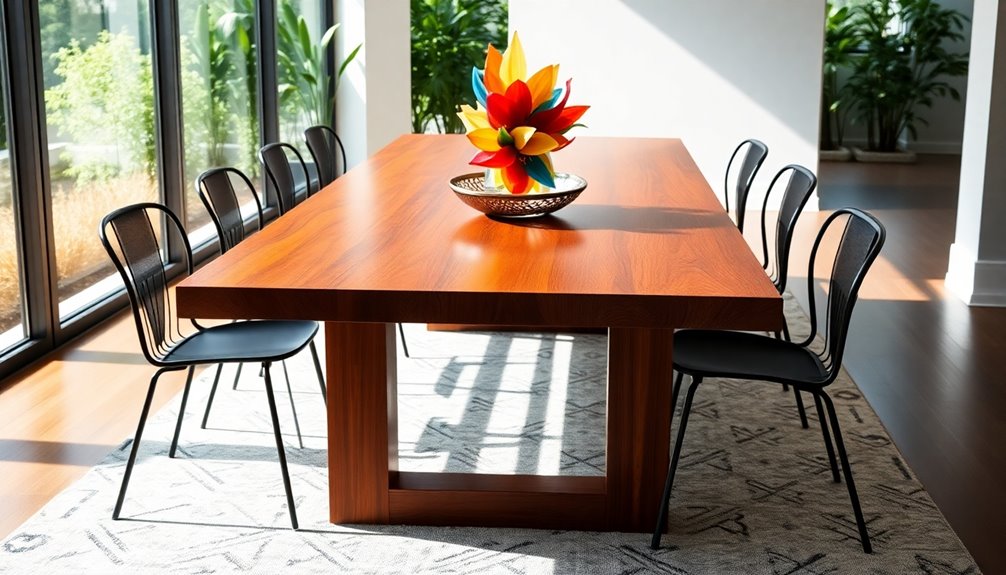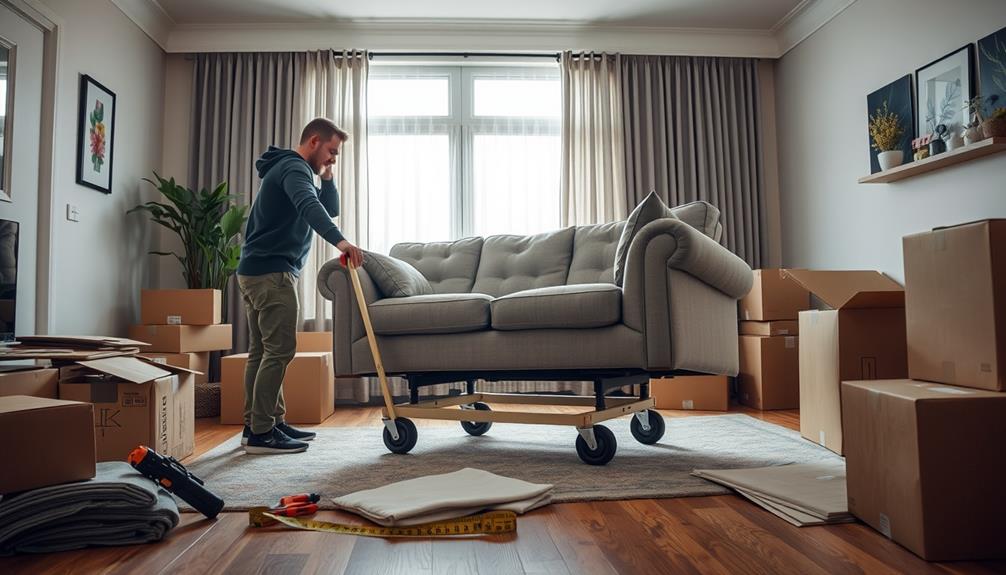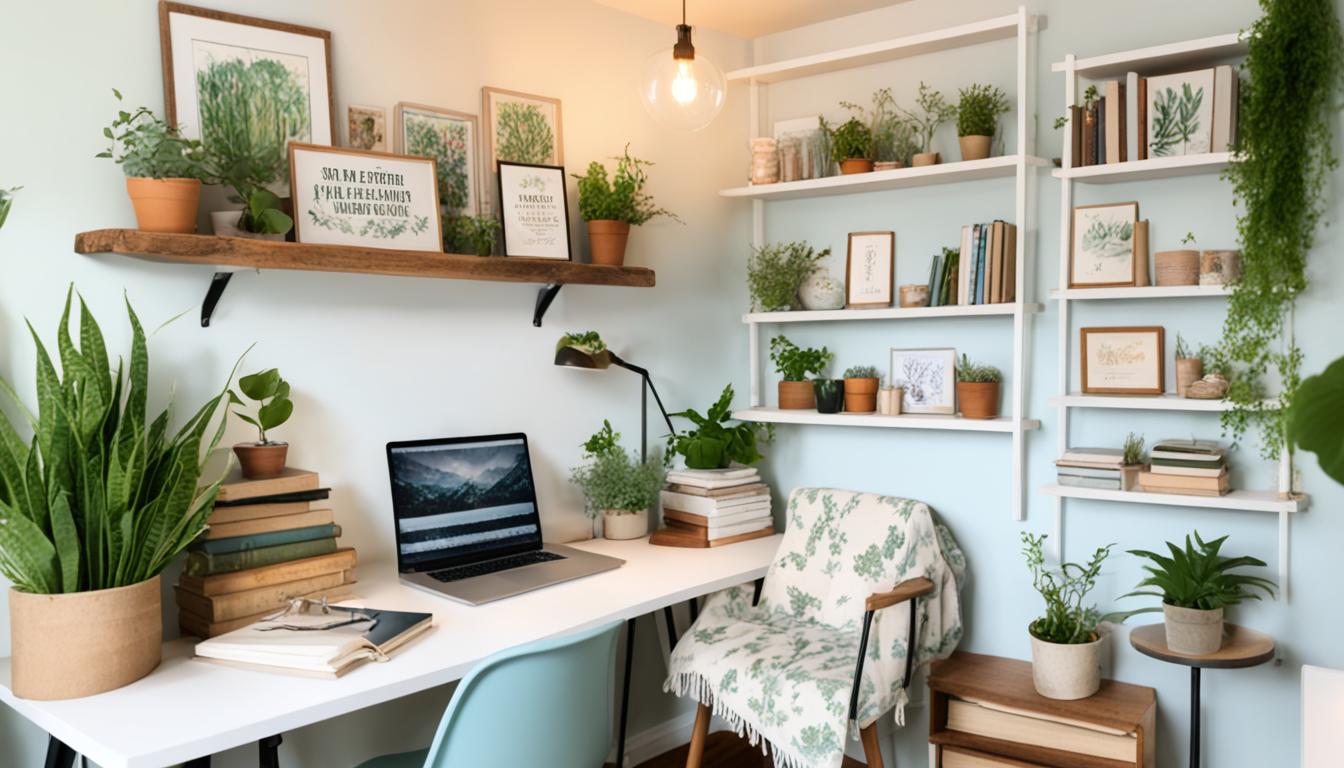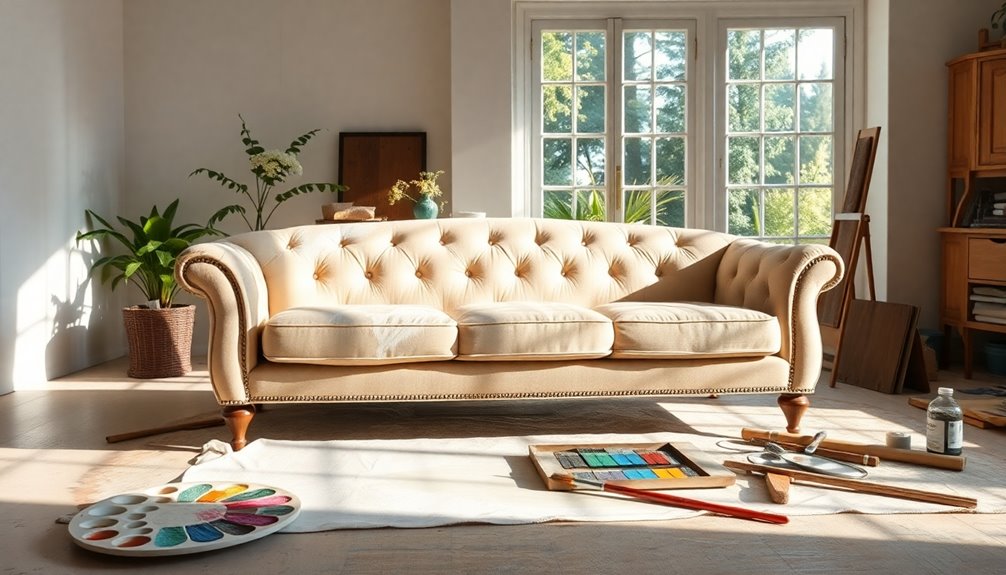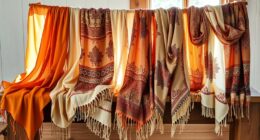To keep your sofa cushions from sliding, try using non-slip covers or shelf liners to increase friction. Reinforcing the cushion frame with plywood or beams can also provide stability. Make sure your cushions fit snugly and consider rotating them regularly to prevent sagging. Opt for textured fabrics that enhance grip and look for heavier upholstery materials for added weight. These simple adjustments will help keep your cushions in place, making your sofa more comfortable. Keep exploring ways to enhance your seating experience and prevent movement effectively.
Key Takeaways
- Use non-slip cushion covers to enhance grip and prevent movement on the sofa.
- Regularly fluff and rotate cushions to maintain their shape and distribute wear evenly.
- Incorporate textured fabrics with higher friction coefficients to minimize sliding.
- Add reinforcement under cushions, such as plywood or support beams, for added stability.
- Consider using elasticized edges or corner straps to secure cushions in place effectively.
Introduction
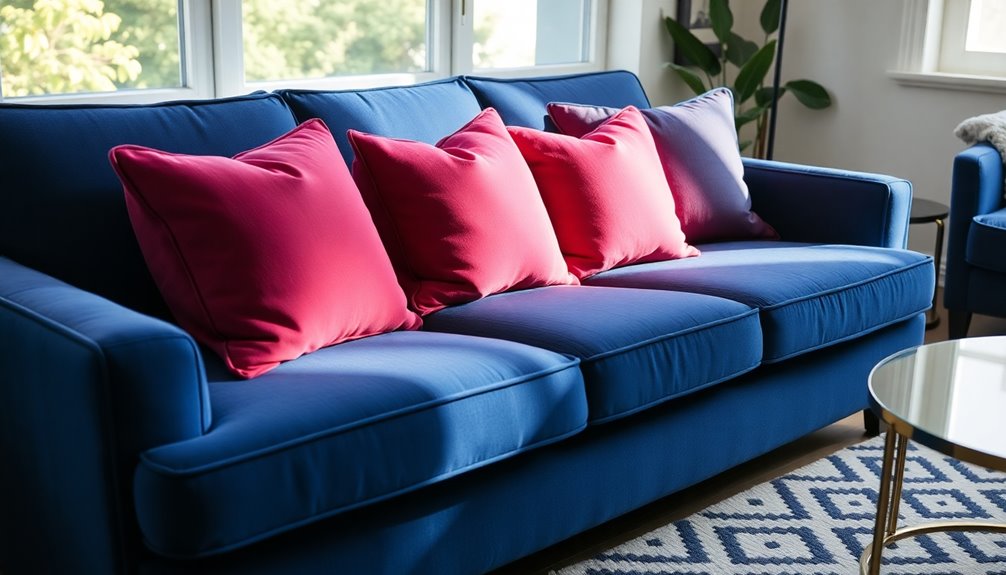
Keeping your sofa cushions in place starts with regular maintenance, like routine fluffing. You'll also want to use the right cleaning techniques tailored to your fabric to maintain their shape and appearance. Plus, if you have pets, addressing odors quickly will help keep your cushions fresh and in good condition.
Routine Cushion Fluffing
Cushions that aren't fluffed regularly can quickly lose their shape and firmness, leading to a slippery sofa experience. To keep your cushions from sliding around, make routine cushion fluffing a priority. Fluffing helps maintain the shape and firmness of your cushions, preventing them from becoming flat and less supportive. Aim to fluff your cushions at least once a week to ensure they stay in top condition.
Proper fluffing techniques involve rotating the cushions and pushing them from the edges toward the center. This redistributes the filling and reduces gaps between the cushions and the couch frame, which is a common cause of movement. By consistently fluffing, you not only enhance the aesthetic appearance of your couch but also prolong the lifespan of your cushions, preventing premature wear.
When you take the time to fluff your cushions regularly, you create a more comfortable and inviting space. Plus, it's an easy task that requires just a few minutes of your time. So, don't skip this step; keep your cushions fluffed, and enjoy a sofa that feels great and stays cozy!
Fabric-Specific Cleaning Techniques
When it comes to maintaining your sofa cushions, understanding fabric-specific cleaning techniques is essential. Each type of fabric requires a unique approach to keep your couch cushions looking great. Always start by checking the manufacturer's care label for specific cleaning instructions. For synthetic fabrics like polyester and nylon, you can typically toss them in the washing machine using cold water and a gentle cycle. This helps maintain their shape and color.
If your cushions are made from natural fibers, such as cotton or linen, opt for a gentle detergent and avoid excessive water to prevent shrinkage. Microfiber can be easily cleaned with a mix of water and mild soap, while leather requires a specialized leather cleaner to maintain its quality.
When a stain occurs, address it immediately. Blot the area with a clean cloth and use a fabric-safe stain remover to prevent permanent discoloration. By employing these fabric-specific cleaning techniques, you'll ensure your couch cushions remain fresh and vibrant, enhancing the overall look of your living space. Regular maintenance will make a significant difference in the longevity and appearance of your sofa cushions.
Eliminating Pet Urine Smells
Dealing with pet urine smells in your sofa can be a frustrating experience, but tackling the issue quickly can make all the difference. When urine seeps into your couch cushions, it can lead to persistent odors and even damage. Start by using an enzymatic cleaner; it effectively breaks down urine components and neutralizes the odors. Be sure to apply it promptly to the affected area for the best results.
After cleaning, sprinkle baking soda on the cushions to absorb any lingering smells. Leave it on for several hours before vacuuming to enhance its effectiveness. Regular vacuuming and fabric fresheners can help, but addressing the stains directly is crucial for long-term odor control.
To protect against future accidents, consider investing in waterproof cushion covers or non-slip fabric that can be easily removed and washed. This not only helps maintain a clean environment but also prolongs the life of your couch cushions. By taking these steps, you can effectively eliminate pet urine odors and keep your sofa fresh and inviting for both you and your furry friends.
Cushion Covers for Added Protection

When you choose cushion covers, consider options made from scratch-resistant and textured fabrics to enhance grip and durability. These materials not only help keep your cushions in place but also protect them from everyday wear and tear. By selecting the right fabric, you can maintain both the functionality and appearance of your sofa.
Scratch-Resistant Fabric Choice
Choosing the right fabric for your sofa cushion covers can make a world of difference in durability and comfort. Opting for scratch-resistant fabric is essential, as it enhances the longevity of your cushions while preventing them from sliding around. Materials like microfiber and synthetic blends are excellent choices; they provide both scratch resistance and a non-slip surface, ensuring your cushions stay in place.
Using non-slip cushion covers not only protects against scratches but also minimizes movement, contributing to a more stable seating experience. This is particularly beneficial in homes with pets or children, where wear and tear can be common. High-quality scratch-resistant fabrics are designed to be easy to clean, reducing the need for frequent replacements and maintaining the appearance of your durable cushions.
Investing in these cushion covers can significantly extend the lifespan of your sofa cushions. By preventing damage from scratches and minimizing sliding, you can enjoy a comfortable and stylish living space for years to come. So, when selecting cushion covers, prioritize scratch resistance and durability to keep your sofa looking its best.
Textured Fabric for Grip
Textured fabric cushion covers can significantly enhance grip and stability, preventing your cushions from sliding on smooth surfaces like leather or polished wood. These non-slip covers come in various styles, making it easy to find one that suits your décor while minimizing shifting during use.
Some non-slip covers are designed with rubberized or silicone backing, increasing the friction coefficient against your couch surface. This added grip effectively holds your cushions in place, giving you peace of mind as you sit down or shift positions. If you're looking for a more customized solution, consider sewing non-slip fabric onto the underside of your existing cushion covers. This method not only keeps your cushions secure but also adds an extra layer of protection against wear and tear.
When selecting cushion covers, prioritize those made from materials with a higher friction coefficient. This choice can significantly reduce the tendency of cushions to slide, making your living space more comfortable and functional. With the right textured fabric cushion covers, you can enjoy a cozy, inviting sofa without the constant hassle of adjusting your cushions.
Durable Fabric Selection
Selecting durable fabrics for your cushion covers not only enhances the longevity of your cushions but also boosts their stability, making them less prone to sliding. Fabrics like canvas or upholstery-grade materials offer excellent durability, ensuring your cushions withstand daily use while maintaining their shape. High-friction fabrics such as tweed or microfiber can significantly improve grip against your couch's surface, thanks to their elevated friction coefficient, which minimizes movement when you sit or stand.
Consider investing in non-slip cushion covers with a textured underside. These designs secure your cushions in place, reducing wear and tear while prolonging the life of both the cushions and your couch. Some covers even feature elasticized edges or corner straps that fit snugly, ensuring your cushions remain firmly anchored without needing extra attachments.
Choosing patterned or heavier upholstery fabrics not only elevates your decor but also adds weight, enhancing stability and preventing slipping. By selecting the right durable fabrics for your cushion covers, you can achieve a stylish and functional solution to keep your cushions securely in place. Additionally, the use of natural materials in your decor can further enhance the overall aesthetic and warmth of your living space.
Cushion Frame Reinforcement

If your sofa cushions are sliding around, the frame might need some reinforcement. By adding support beams or a plywood board, you can create a more stable base that keeps your cushions in place. Regularly checking for loose components can also enhance overall stability and ensure your cushions stay put.
Cushion Frame Stability Concerns
A sturdy cushion frame is essential for keeping your sofa cushions from sliding around during use. When you reinforce the cushion frame, you enhance its stability, which significantly reduces the likelihood of those sliding cushions. One effective method is to add plywood or particle board beneath loose cushions. This creates a firmer surface that prevents sagging and keeps the cushions in place.
You should also check for any loose joints or screws in the sofa frame. Tightening these can greatly improve the overall stability of the seating area, minimizing cushion movement. Make sure your frame is constructed from durable materials, like hardwood, to maintain the integrity of the couch and effectively support the cushions. Additionally, consider the height of your sofa, as it can affect both comfort and aesthetics. If you find that your sofa is too low for your preference, there are several ways to elevate it. For example, you might explore how to increase sofa height by adding furniture risers or swapping out the original legs for taller ones, which can also enhance the overall design of your living space.
Regularly inspecting the frame for wear and tear is crucial. Identifying potential stability issues early lets you make timely repairs, helping to prevent cushion sliding. With these steps, you can ensure that your cushion frame remains strong and stable, allowing you to enjoy a comfortable seating experience without the frustration of constantly adjusting your cushions.
Cushion Support Frame Repair
After ensuring your cushion frame is stable, you might find that some cushions still slide due to inadequate support beneath them. This is where cushion support frame repair comes into play. To reinforce your sofa's structure, consider using materials like plywood, hardwood strips, or metal brackets. These additions can provide the extra stability your cushions need to stay in place.
Before starting the repair, measure the existing frame to ensure that any added materials match in dimensions. This helps maintain the couch's overall aesthetics while enhancing its functionality. Regularly inspect the support frame for signs of wear or damage; a compromised frame can lead to increased cushion movement and discomfort.
When installing these reinforcements, use screws or brackets securely to ensure they hold up under the weight and pressure of regular use. Proper installation techniques are essential for achieving lasting stability. By taking these steps, you'll not only improve the support frame but also enjoy a more comfortable seating experience without the annoyance of sliding cushions.
Enhanced Cushion Stability
To enhance cushion stability, consider implementing various reinforcement techniques that effectively minimize sliding. One effective method is to add non-slip materials like heavy-duty Velcro or rubber pads. By installing a hook and loop system directly onto your couch frame and the cushions back, you create a secure attachment that keeps sofa cushions firmly in place during use.
If you're looking for a more permanent solution, try utilizing upholstery tacks to fasten the cushions to the couch frame. While this method minimizes slipping, keep in mind that it may leave small holes in the fabric. Another option is a ring and hook system, where you sew fabric loops onto both the cushions and the couch frame, effectively preventing them from sliding off.
Additionally, ensure that the couch frame has a tight-back design or is constructed from materials with higher friction properties. This can further enhance cushion stability, making it less likely for your sofa cushions to shift. By employing these techniques, you can enjoy a well-organized and comfortable seating area without the frustration of sliding cushions.
Cushion Size Adjustments
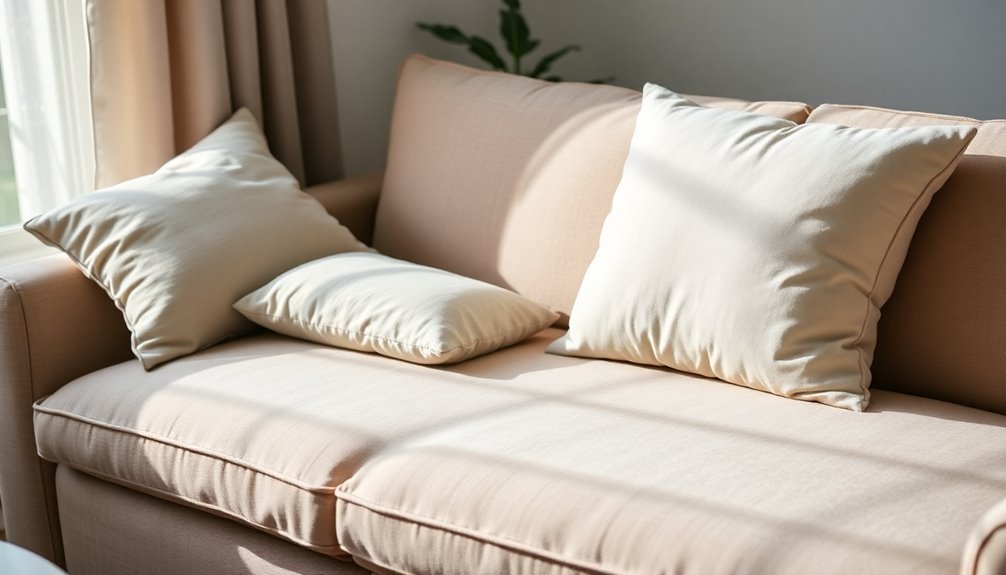
Finding the right cushion size is crucial for preventing sliding on your sofa. If there are gaps between your cushions and the couch frame, movement is almost inevitable. Start by measuring your cushions and comparing those dimensions to the seat area of your sofa. This helps identify any size discrepancies that could be causing the sliding issue.
If your cushions are too small, consider adjusting by using slightly larger cushions or adding extra padding to your existing ones. This creates a tighter fit and enhances stability. For those persistent gaps, you might want to use non-slip materials, like shelf liners, to fill in the spaces and add friction between the cushions and the sofa.
Additionally, regularly replacing worn or flattened cushions with firmer, properly sized options can help maintain their shape. By making these adjustments, you'll significantly reduce the chances of your cushions sliding around. Remember, a snug fit is key to enjoying a comfortable and stable seating experience on your sofa.
Cushion Rotation for Longevity
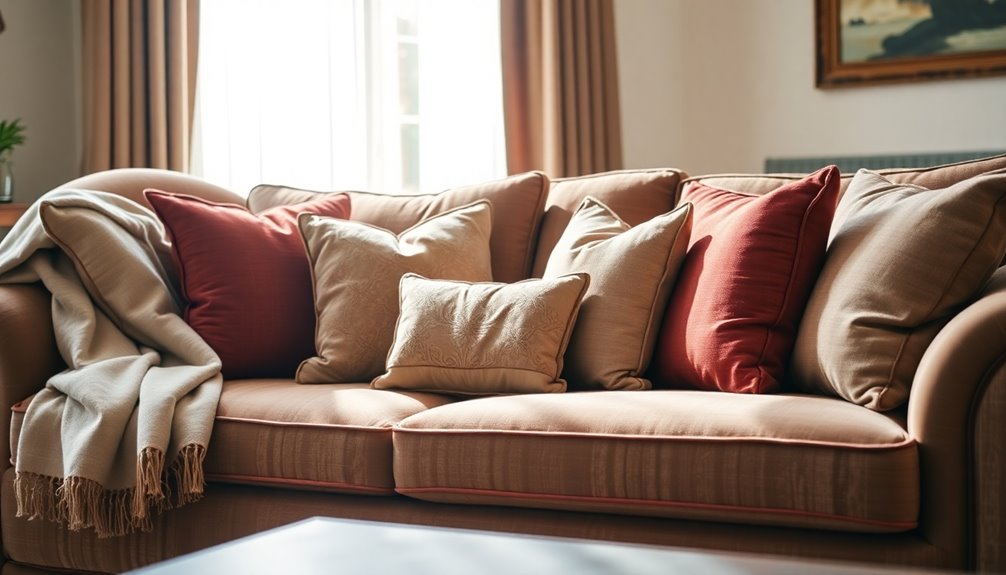
Cushion rotation is a simple yet effective technique that can dramatically extend the life of your sofa cushions. By regularly rotating your couch cushions every few weeks, you help distribute wear evenly, which prolongs their lifespan and maintains their shape. Frequent rotation can prevent sagging, as it minimizes pressure on specific areas and promotes uniform compression of the filling material.
For optimal results, rotate cushions from different seats to ensure all sides experience equal use. This practice enhances both comfort and aesthetics, making your sofa look and feel better. Additionally, incorporating cushion rotation into your regular cleaning routine can help remove debris and dust, contributing to a healthier living environment.
Many manufacturers recommend rotating cushions as part of their care instructions, emphasizing the importance of this practice in preserving the integrity of your sofa for years. So, take the time to care for your couch cushions by rotating them regularly. Not only will you enjoy a more comfortable seating experience, but you'll also protect your investment in your furniture. By adopting this simple habit, you'll ensure your cushions remain in great shape for longer.
Conclusion
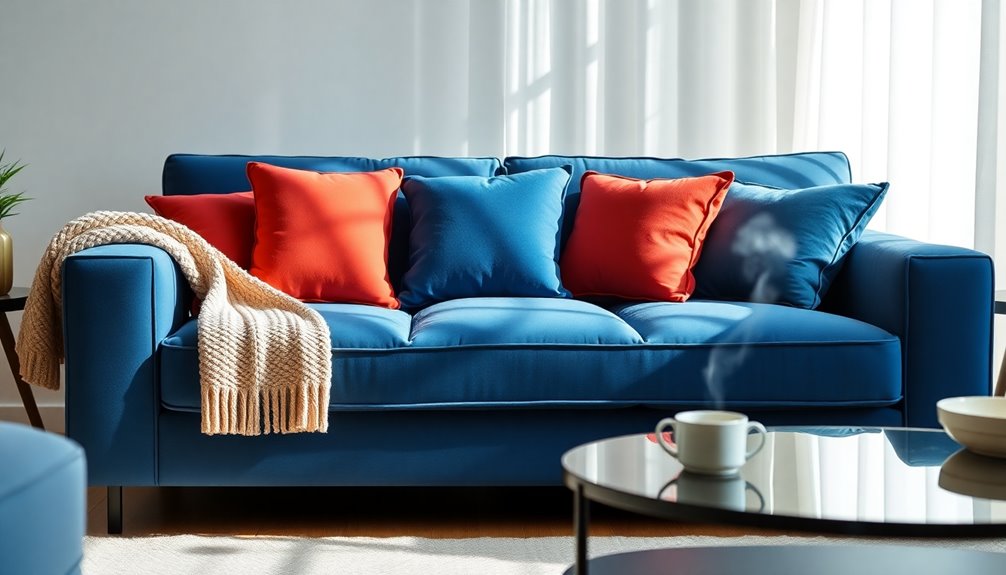
Maintaining stability in your sofa cushions is essential for both comfort and aesthetics. To keep your cushions securely in place, consider implementing several effective strategies. Start by using non-slip materials like rug pads or rubber pads. These create friction between your cushions and the couch frame, significantly reducing slippage.
For a more adhesive approach, Velcro strips or rug tape can be a game-changer. Simply apply them to the underside of your cushions and the couch base. This quick and easy solution ensures a strong hold, keeping your cushions from shifting during use. Additionally, non-slip cushion covers can enhance both protection and stability, minimizing movement while also upgrading your decor.
Don't forget about regular maintenance! By replacing foam inserts or adding stuffing, you can improve cushion firmness, further decreasing the likelihood of sliding. Combining multiple methods—like using non-slip pads alongside Velcro—can yield the best results for long-lasting comfort and stability.
Frequently Asked Questions
How Do You Stop Seat Cushions Slipping on Sofa?
To stop your seat cushions from slipping on the sofa, try using non-slip materials like rug pads or sticky shelf liners. You can also apply Velcro strips to both the cushions and the frame for a strong grip. Consider repurposing non-slip mattress pads or placing heavy-duty rubber mats underneath the cushions for extra stability. Regularly adjust your cushions and check their condition to keep everything in place and reduce movement.
How to Make Sofa Cushions Stay in Place?
To make your sofa cushions stay in place, you can try a few effective solutions. Use non-slip materials like rubber shelf liners or rug pads under each cushion for added friction. Velcro strips can also work wonders; stick them to both the cushions and the sofa frame. Alternatively, consider sewing non-slip fabric onto the cushion covers. Regularly fluffing and adjusting your cushions helps keep them looking neat and in position, too!
How to Fix Couch Cushions That Slide Out?
If your couch cushions are sliding out, you've got several options. Try using heavy-duty Velcro strips to secure them to the frame, or place non-slip rug pads underneath for extra grip. Sticky shelf liners can also help without permanent changes. For a more lasting fix, sew fabric loops onto the cushions and frame, connecting them with S-hooks. Regularly check your solutions to ensure they're still effective and make adjustments as needed.
How Do You Keep Couch Cushions Attached?
To keep your couch cushions attached, try using heavy-duty Velcro strips to secure them to the couch frame. You can also place non-slip mattress pads or rubber pads underneath for extra grip. If you're looking for a more permanent solution, sew fabric loops onto the cushions and couch, connecting them with keyrings or S-hooks. Don't forget to regularly check the adhesive strength of your methods to ensure they remain effective over time.
